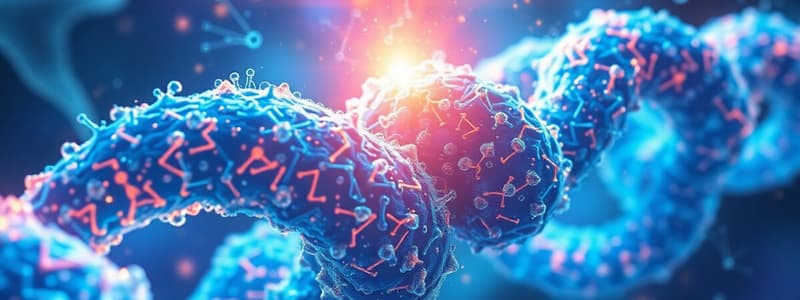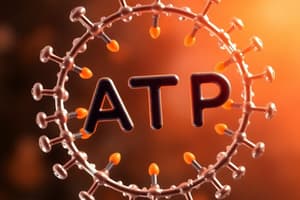Podcast
Questions and Answers
Which component of ATP contains a high-energy bond that, when broken, releases energy for cellular processes?
Which component of ATP contains a high-energy bond that, when broken, releases energy for cellular processes?
- Adenine base
- Phosphate groups (correct)
- Ribose sugar
- Adenosine
According to the first law of thermodynamics, what happens to the energy stored in glucose during cellular respiration?
According to the first law of thermodynamics, what happens to the energy stored in glucose during cellular respiration?
- It is destroyed to power cellular activities.
- It is transformed into ATP and heat. (correct)
- It is lost entirely from the system.
- It is converted to matter to build cell structures.
During oxidation-reduction (redox) reactions, what process occurs when a molecule gains electrons?
During oxidation-reduction (redox) reactions, what process occurs when a molecule gains electrons?
- Hydrolysis
- Oxidation
- Reduction (correct)
- Synthesis
What type of chemical reaction involves the breakdown of complex molecules into simpler ones, releasing energy in the process?
What type of chemical reaction involves the breakdown of complex molecules into simpler ones, releasing energy in the process?
Which term best describes a reaction that requires energy input in order to proceed?
Which term best describes a reaction that requires energy input in order to proceed?
Which of the following is an example of potential energy?
Which of the following is an example of potential energy?
What is the primary consequence of the second law of thermodynamics in energy transformations?
What is the primary consequence of the second law of thermodynamics in energy transformations?
In a reversible reaction, what factor determines the direction in which the reaction will proceed?
In a reversible reaction, what factor determines the direction in which the reaction will proceed?
Which type of reaction combines two or more reactants to form a larger molecule?
Which type of reaction combines two or more reactants to form a larger molecule?
What is the immediate product when ATP is hydrolyzed to release energy?
What is the immediate product when ATP is hydrolyzed to release energy?
Which of the following best describes an irreversible reaction?
Which of the following best describes an irreversible reaction?
Which of the following statements accurately defines 'activation energy'?
Which of the following statements accurately defines 'activation energy'?
What is the primary function of enzymes in biochemical reactions?
What is the primary function of enzymes in biochemical reactions?
Which event occurs first in the mechanism of enzyme action?
Which event occurs first in the mechanism of enzyme action?
What is the role of cofactors in enzyme function?
What is the role of cofactors in enzyme function?
How does increasing substrate concentration typically affect the rate of an enzyme-catalyzed reaction?
How does increasing substrate concentration typically affect the rate of an enzyme-catalyzed reaction?
What happens to an enzyme's activity at temperatures significantly higher than its optimum?
What happens to an enzyme's activity at temperatures significantly higher than its optimum?
How does a competitive inhibitor affect enzyme activity?
How does a competitive inhibitor affect enzyme activity?
In noncompetitive inhibition, where does the inhibitor bind?
In noncompetitive inhibition, where does the inhibitor bind?
How does negative feedback regulate metabolic pathways?
How does negative feedback regulate metabolic pathways?
Flashcards
ATP Structure
ATP Structure
Adenosine triphosphate consists of an adenine base, ribose sugar, and three phosphate groups.
ATP Function
ATP Function
ATP is the primary energy currency in cells, fueling processes like muscle contraction and transport.
ATP Release
ATP Release
Energy is released when ATP is hydrolyzed to ADP and inorganic phosphate, breaking bonds.
Potential Energy
Potential Energy
Signup and view all the flashcards
Kinetic Energy
Kinetic Energy
Signup and view all the flashcards
First Law of Thermodynamics
First Law of Thermodynamics
Signup and view all the flashcards
Second Law of Thermodynamics
Second Law of Thermodynamics
Signup and view all the flashcards
Synthesis Reactions
Synthesis Reactions
Signup and view all the flashcards
Catabolic Reactions
Catabolic Reactions
Signup and view all the flashcards
Oxidation-Reduction (Redox) Reactions
Oxidation-Reduction (Redox) Reactions
Signup and view all the flashcards
Irreversible reaction
Irreversible reaction
Signup and view all the flashcards
Reaction rate
Reaction rate
Signup and view all the flashcards
Activation energy
Activation energy
Signup and view all the flashcards
Catalyzed reaction
Catalyzed reaction
Signup and view all the flashcards
Uncatalyzed reaction
Uncatalyzed reaction
Signup and view all the flashcards
Structure of enzymes
Structure of enzymes
Signup and view all the flashcards
Active site
Active site
Signup and view all the flashcards
Cofactors
Cofactors
Signup and view all the flashcards
Competitive inhibition
Competitive inhibition
Signup and view all the flashcards
Metabolism
Metabolism
Signup and view all the flashcards
Study Notes
ATP Structure and Function
- ATP (adenosine triphosphate) is the primary energy currency in cells
- ATP structure consists of: adenine base, ribose sugar, and three phosphate groups
- High-energy bonds connect phosphate groups
- ATP provides energy for various cellular processes (muscle contraction, transport, chemical reactions)
- Energy is stored in the bonds between phosphate groups
- Hydrolysis of ATP to ADP (adenosine diphosphate) and inorganic phosphate (Pi) releases energy
Energy Types and Thermodynamics
- Potential energy is stored energy due to position or structure (e.g., in chemical bonds)
- Kinetic energy is the energy of motion (e.g., moving particles, heat)
- The first law of thermodynamics states energy cannot be created or destroyed, only transformed
- The second law of thermodynamics states that energy transformations are inefficient, and some energy is always lost as heat, increasing entropy (disorder)
Chemical Reactions
- Synthesis reactions combine two or more reactants to form a larger molecule
- Decomposition reactions break down a large molecule into smaller molecules or atoms
- Exchange reactions involve breaking and reforming bonds, rearranging reactants
- Oxidation-reduction (redox) reactions involve electron transfer (oxidation and reduction)
- Anabolic reactions build complex molecules, requiring energy
- Catabolic reactions break down complex molecules, releasing energy
- Endergonic reactions require energy input
- Exergonic reactions release energy
- Reversible reactions can proceed in both directions
- Irreversible reactions proceed in one direction only
Reaction Rates and Enzymes
- Reaction rate is the speed at which reactants are converted to products
- Activation energy is the minimum energy needed to start a reaction
- Catalyzed reactions are accelerated by enzymes as catalysts
- Uncatalyzed reactions proceed slower without a catalyst
- Enzymes are proteins with specific 3D shapes, including an active site where substrates bind
- Enzymes lower activation energy, speeding up biochemical reactions
- Substrates bind to enzymes at the active site, forming a complex, and reacting
- Cofactors (non-protein molecules) assist in catalysis (e.g., metal ions or vitamins)
Enzyme Effects and Inhibition
- Substrate concentration increases reaction rates until enzymes are saturated
- Temperature affects enzyme activity; optimal temperatures maximize activity
- pH affects enzyme activity; each enzyme has an optimal pH range
- Competitive inhibitors block the active site, preventing substrate binding
- Non-competitive inhibitors bind to a different site (allosteric site), altering enzyme shape and reducing activity
Metabolism and Feedback
- Metabolism is the sum of all chemical reactions in a cell or organism
- Metabolic pathways are examples of negative feedback, where final products inhibit the earlier steps to regulate pathway activity
- Negative feedback maintains homeostasis
Studying That Suits You
Use AI to generate personalized quizzes and flashcards to suit your learning preferences.




